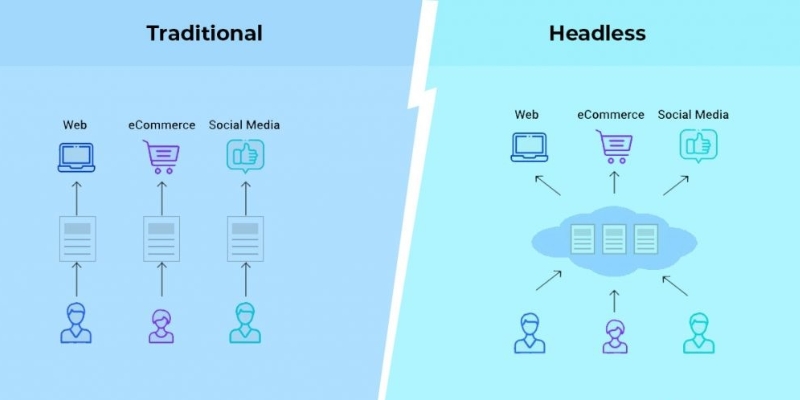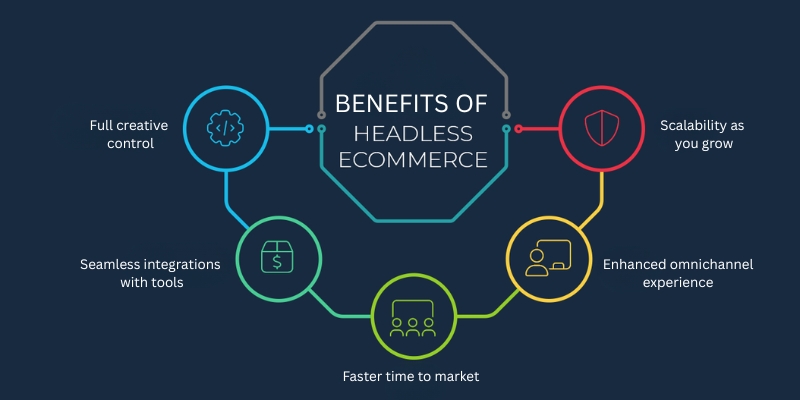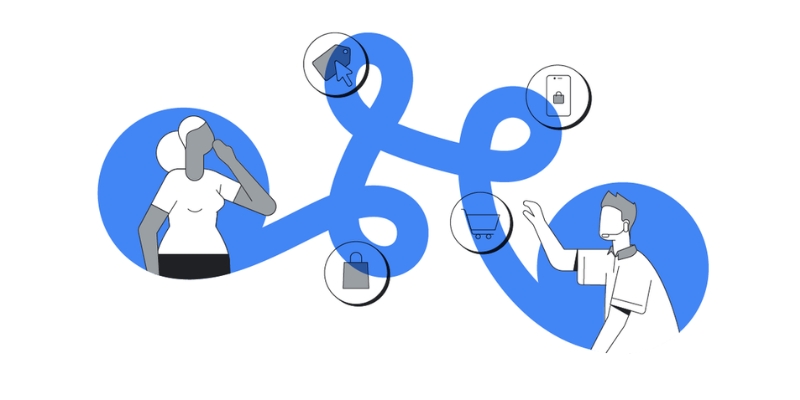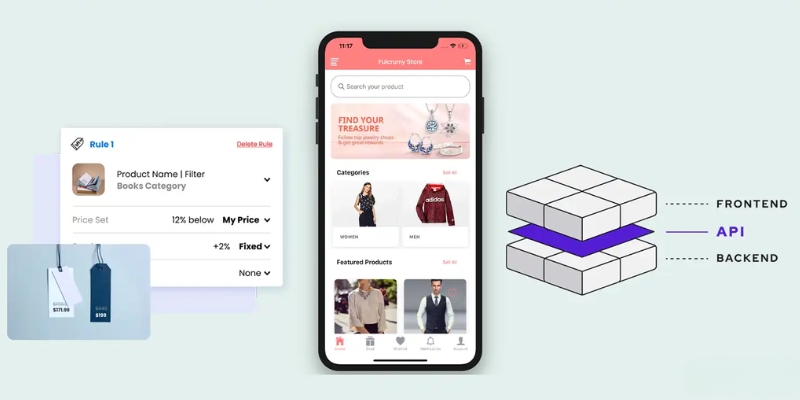Lucia Lee
Last update: 24/09/2025
Shoppers today expect lightning-fast websites, personalized experiences, and seamless shopping across every device. While traditional ecommerce platforms struggle to provide them, headless commerce is designed to solve just that. This architecture gives you the agility to innovate quickly, deliver consistent customer journeys, and scale without being held back by rigid systems. In this guide, we’ll break down what headless commerce really means, its core benefits, and how to decide if it’s the right move for your business.
At its core, headless commerce is an ecommerce architecture that separates the customer-facing layer (your storefront, apps, or kiosks) from the behind-the-scenes systems that manage data, transactions, and business logic. This frontend decoupling means your design, content, and customer experience can evolve freely without being tied to rigid backend structures.
By adopting an API-first approach, businesses can connect their backend with multiple touchpoints - whether it’s web, mobile, voice, or even IoT devices - while maintaining a single source of truth for inventory, product data, and orders. This flexibility unlocks a true omnichannel experience, where customers enjoy consistent and seamless shopping journeys across every platform.
Also read: Social Commerce 101: Definition, Benefits, Trends, And More
Traditional ecommerce platforms follow a tightly coupled model where the front end and back end are directly linked. This setup makes it quick and easy to launch a store, often with prebuilt templates and drag-and-drop tools. For small businesses just entering digital commerce, this can be appealing because of its simplicity and speed. However, the downside becomes apparent as you grow: even minor design tweaks can ripple into the back end, creating unexpected issues with payment systems, inventory management, or other core functions. Over time, this rigidity limits customization and makes adding new software integrations more challenging.
By contrast, headless commerce takes a very different approach. Through decoupling, the front end and back end operate independently, connected by APIs. This separation gives businesses the freedom to design unique storefronts, introduce new channels, and update features without disrupting core operations. The result is not only endless design possibilities but also improved user experience, since updates can be made faster and with fewer risks.

Headless commerce vs traditional commerce
Headless commerce is more than a buzzword among the emerging ecommerce trends; it’s a powerful way for ecommerce brands to stay agile, innovative, and customer-focused. Here are some of the biggest benefits of headless commerce that you won’t want to miss out on:
Full creative control
With traditional platforms, your storefront design is tied to rigid templates. Headless commerce removes those restrictions through frontend decoupling, giving your team the freedom to craft unique digital experiences. You can experiment with bold visuals, interactive elements, or even gamified checkouts without being limited by the backend system. Plus, A/B testing becomes simpler, so you can continuously refine the experience to boost conversions. In short, you’re no longer designing within someone else’s box - you’re building your own.
Seamless integrations with preferred tools
Every ecommerce business runs on a stack of tools - from ERP and CRM systems to analytics and payment gateways. Traditional ecommerce platforms can make integration messy or even impossible. Headless commerce solves this with an API-first approach, allowing your backend to “talk” effortlessly to the tools you already use. Developers can also adopt a composable tech stack, swapping in best-of-breed services whenever needed without disrupting the whole system. This flexibility keeps your business future-proof.
Faster time to market
In ecommerce, speed matters not only for customers but also for businesses. Headless commerce allows you to launch new storefronts, campaigns, or channels quickly without tying up backend resources. Marketing teams can roll out seasonal promotions or experiment with new touchpoints in days, not weeks. This agility gives you a competitive edge in responding to trends or entering new markets.
Scalability as you grow
As your customer base expands and traffic spikes, you need an ecommerce architecture that grows with you. Headless commerce platforms support scalability by letting you add new front-end experiences, markets, or services without overhauling the entire system. This modular approach helps future-proof your business while protecting your initial investments.
Enhanced omnichannel experience
Modern shoppers expect a consistent journey whether they’re browsing your ecommerce website, using your mobile app, or shopping in-store. Headless commerce makes delivering this omnichannel experience possible by connecting every touchpoint to the same backend. This ensures seamless branding, unified inventory management, and a smooth shopping journey across all platforms - building stronger customer loyalty.

Benefits of headless commerce for businesses
So far, we’ve explored how headless commerce benefits businesses. But its power doesn’t stop there - it’s also transforming the shopping experience for your customers. After all, satisfied shoppers are the key to loyalty and repeat revenue. Here are the main ways headless architecture impacts them:
Personalized shopping experiences
Modern consumers expect brands to understand their unique preferences - and headless commerce makes this possible. With frontend decoupling, merchants can test and deploy personalized promotions, recommendations, and dynamic content without breaking the backend. By leveraging customer data from multiple touchpoints, you can serve up tailored offers, targeted product suggestions, and engaging campaigns that feel relevant and personal. The result? Stronger relationships and greater brand loyalty.
Faster access to new features and offers
Shoppers are always on the lookout for fresh experiences, whether that’s a new checkout option, payment method, or a seasonal campaign. With a headless commerce setup, businesses can roll out updates much faster - sometimes in days instead of weeks. That means customers get instant access to the latest promotions, designs, or shopping features without delays, keeping their experience exciting and up to date.
Seamless omnichannel journeys
Today’s buyers move fluidly between channels: browsing products on Instagram, checking reviews on mobile, and completing purchases on desktop - or even in-store. A headless commerce platform ensures these transitions feel effortless. By connecting every touchpoint to the same backend via APIs, customers enjoy a unified experience wherever they engage with your brand. For example, a shopper can discover a product on social media and complete the checkout without ever leaving the app.

Seamless omnichannel journeys
Faster site speed and reliable performance
Few things drive customers away faster than a slow-loading website. Headless commerce architecture is designed to handle spikes in traffic and keep pages loading quickly, even during peak shopping seasons. This not only reduces bounce rates but also ensures customers have a smooth and frustration-free shopping journey. A faster site means fewer abandoned carts and more completed purchases.
The honest answer is: it depends. Unlike traditional platforms with more fixed pricing models, the cost of headless commerce varies widely based on your business goals, chosen architecture, and the partners you work with. Here’s a breakdown of the key cost factors involved to help you get a clearer picture.
While headless commerce brings about various benefits, it’s not the best solution for all. If your business is running smoothly on a traditional platform and you don’t need advanced flexibility, sticking with what works might be the most practical path. But for brands looking to differentiate themselves, accelerate growth, and deliver unique customer experiences, going headless can be a game changer.
Here are a few signs headless commerce might be the right fit for you:
If these challenges resonate, investing in headless can future-proof your business by giving you the flexibility, scalability, and omnichannel readiness to stay competitive in a fast-evolving digital commerce landscape.

Determine if headless commerce is the right choice for your business
Also read: Optimized Ecommerce Platform For Online Sales: A 101 Guide
If you’ve decided headless commerce is the right move for your business, the big question now is how to get started. To make the transition successful, you’ll need a thoughtful plan, the right tools, and clarity on your business goals. Follow these steps to go headless:
Define your goals
Start by identifying what you want to achieve - whether it’s faster site performance, deeper personalization, or a stronger omnichannel presence. Understanding customer behavior (e.g., mobile-first shopping, cross-platform browsing, or demand for same-day delivery) will help you align your headless strategy with real needs.
Choose the right platform
Not every platform is built for headless agility. Look for solutions that are API-first, composable, and support modular systems so you can start small and scale fast. Many businesses buy off-the-shelf headless platforms with prebuilt APIs and integrations, while others build their own for full control. A hybrid approach - mixing prebuilt services with custom development - is also common.
Design a flexible frontend
With frontend decoupling, you can craft customer experiences without being tied down by backend logic. This is where you can innovate with responsive design, personalized shopping journeys, and features like quick reorders or saved checkouts. Some vendors even offer starter templates (e.g., for PWAs or mobile apps) that accelerate deployment while leaving room for customization.
Integrate and test
Connect your backend systems - OMS, PIM, payments, CMS, CRM - through APIs, then rigorously test the customer journey across devices. Make sure checkout works everywhere, data syncs correctly, and fallback flows exist for high-traffic moments or out-of-stock items.
Start small, then scale
Instead of overhauling your entire platform at once, begin with a proof of concept, like a custom landing page or a single storefront. This phased rollout minimizes risk, helps your team learn quickly, and builds momentum before expanding globally.
While headless commerce offers undeniable flexibility and innovation, it also comes with challenges that businesses should carefully weigh before making the switch.
High development and maintenance costs
Building and maintaining a decoupled system often requires larger upfront investments compared to traditional platforms. Expenses include development resources, third-party integrations, hosting, and ongoing updates. Licensing or subscription fees from vendors can also add up over time.
Need for advanced technical expertise
A successful headless setup relies on skilled developers familiar with APIs, integrations, and microservices. Without the right in-house talent or a reliable agency partner, businesses may face steep learning curves and higher outsourcing costs.
Complex integrations
While flexibility is a key advantage, it also brings complexity. Unlike traditional platforms where many tools are plug-and-play, headless requires careful integration of CMS, CRM, OMS, and other third-party systems. Any issues with APIs can disrupt site performance and impact the customer experience.
Data migration and infrastructure demands
Moving existing product catalogs, customer records, and order histories into a headless environment can be time-consuming and costly, especially if data is outdated or poorly formatted. On top of this, businesses must budget for hosting, infrastructure scaling, and regular security patches.
Consistency and security challenges
Because headless supports multiple channels (web, mobile, IoT, POS), maintaining a consistent user experience across all touchpoints can be difficult. The decentralized flow of data also raises the stakes for security, requiring strong authentication, encryption, and continuous monitoring to prevent breaches.
While headless commerce offers remarkable flexibility and scalability, it also comes with its own set of challenges - from higher development costs to greater technical complexity. To truly gain the benefits without being weighed down by obstacles, businesses need a trusted partner who can simplify the journey. That’s where Sky Solution comes in. With tailored e-commerce solutions built to match your goals, we help you unlock the full power of headless commerce and stay ahead in today’s competitive market. Contact us now for a free consultation!